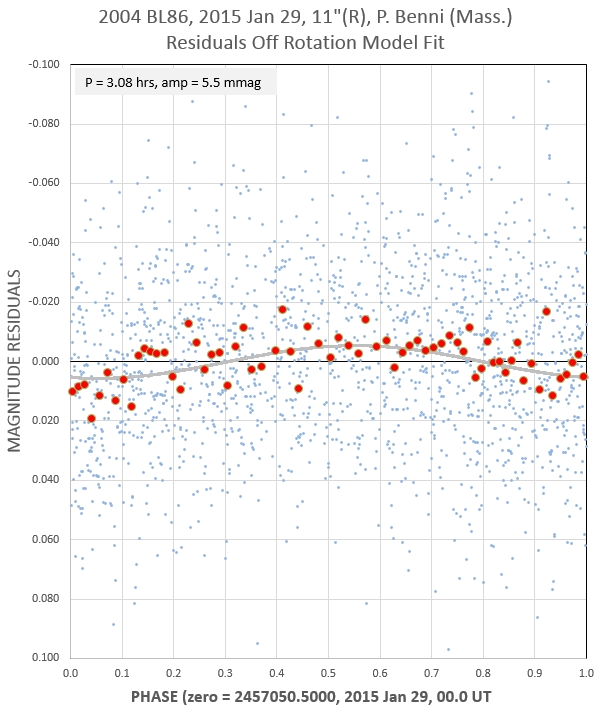
Observing Fast-Moving Asteroids
Bruce L. Gary, Last Updated
2015.01.30
This web page is
meant to provide observing and processing tips for
observing fast-moving asteroids, e.g., 2004 BL86.
Suggested processing procedure is at http://brucegary.net/BL86/calibration.html
Current
Observing Status
2015.02.03, 03:50 UT: B.Gary
observed 5.5 hrs on Feb 02, UT (2 rotations), and
obtained a phase-folded LC that matches the other ones.
This means that BL86 is not a "tumbler."
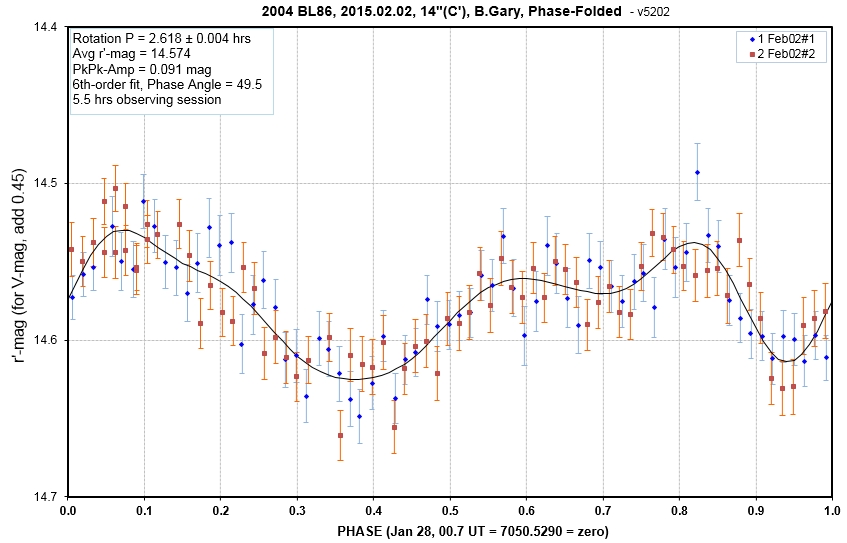
2015.01.31, 02:00 UT: P.
Benni's Jan 29 data has residuals off the 2.608-hr
rotation model that exhibit a 3.08-hr variation, with
semisamplitude 5.5 mmag, as shown by the graph
below. THis might be due to the rotation of the
smaller of the binary components. So far we haven't seen
any "mutual events" (transits, eclipses or shadow
fadings), so apparently the binary orbit spin axis
wasn't oriented in a favorable way for such events to be
seen from Earth at our observing times.

2015.01.30, 22:20 UT: P.
Benni's Jan 29 R-band data, a continuous run lasting
10.7 hours, provided an excellent solution for rotation
period. I used it in combination with my Jan 28 data
(3.6 hrs) to refine the rotation period even further.
Below are both data sets plotted as a phase-folded LC.
Rotation P = 2.608 ± 0.005 hours. A slight
difference in the phase-folded LC shape can be expected
due to the different observing geometry, being one day
apart.


2015.01.30, 04:50 UT: B.
Gary reports a rotation period of 3.8 hours, based on
one night's 3.5 hr observing session. The light curve is
complicated, as the graph below shows. This result has
to be tentative since there is no phase overlap; i.e.,
the observing session is shorter than the solution
rotation period. We need a longer data set to be more
certain about the period. We have plenty of long data
sets, but it will just take time to process them.
(Incidentally, I can produce a visible albedo spectrum,
from ~ 450 to 850 nm, for any of the times in the graph,
below, because this LC was produced from the zero-order
images taken with a SA-100 transmission grating.)
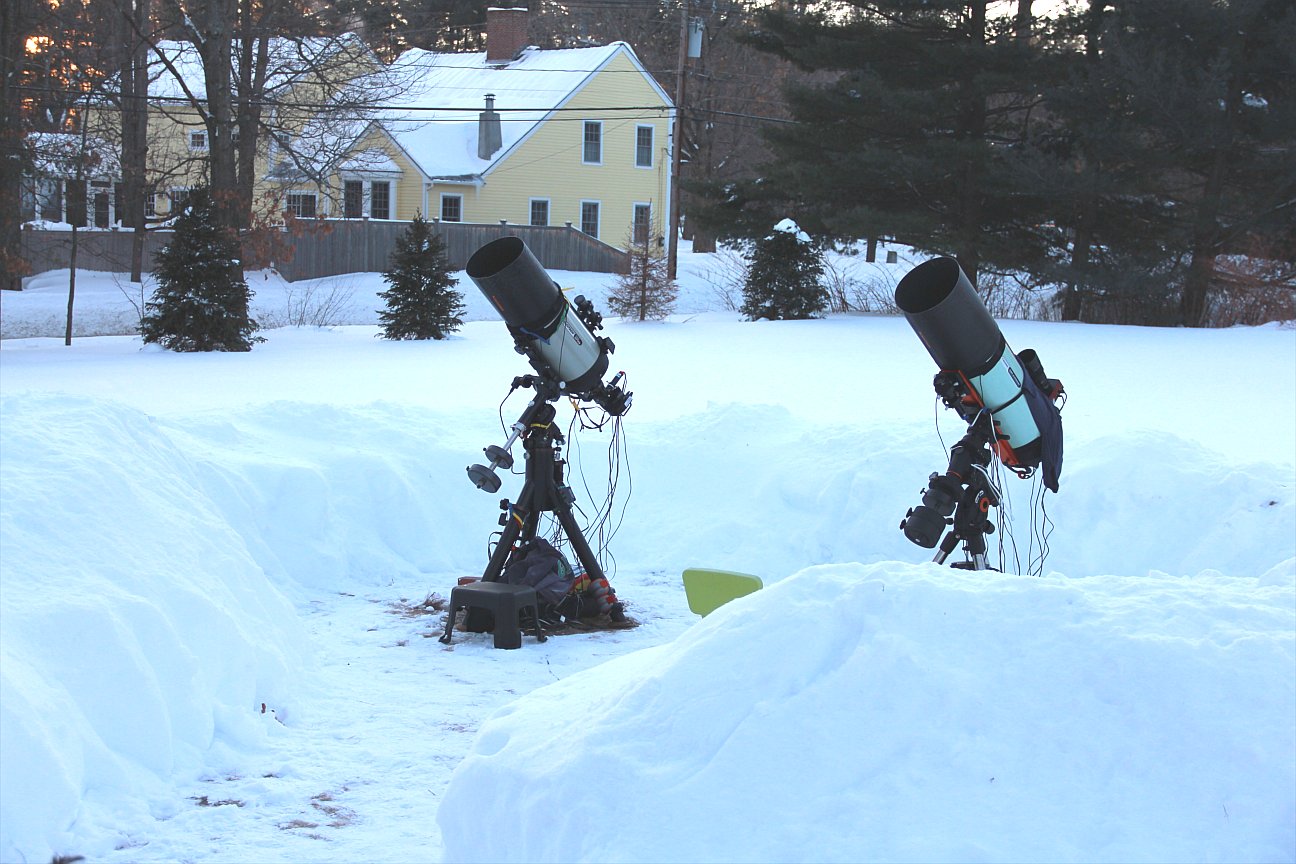
2015.01.29, 00:20 UT: P. Benni is observing. hoping to see a mutual event and at least confirm rotation period.
2015.01.28, 23:40 UT: The data
coffers are FULL, so no more observations are needed.
Last night J. Garlitz got 6 hours, T. Kaye got ~ 5 hrs
&, I got ~ 4 hrs (of SA-100 observations). Here's an
updated plot of albedo & geometric albedo, and
another plot comparing geometric albedos of BL86 and
Vesta.

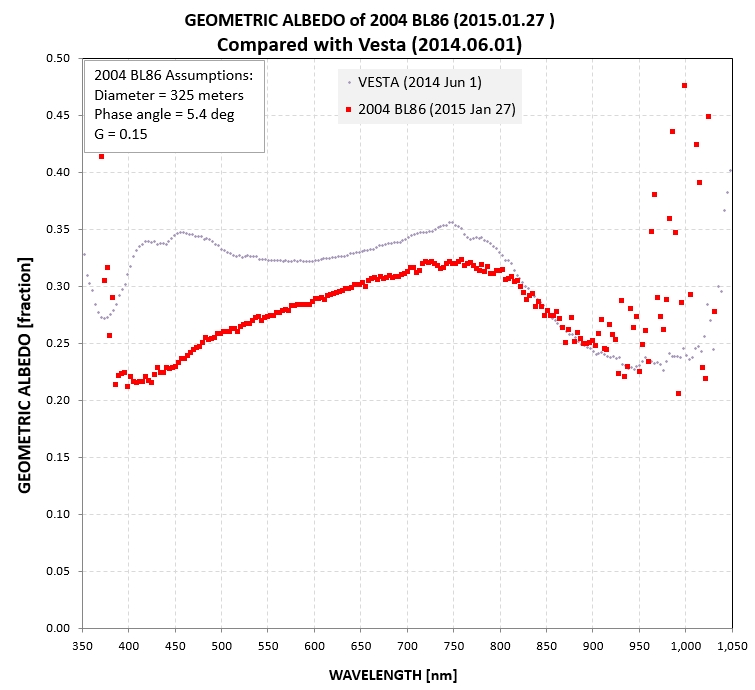
2015.01.27, 21:20 UT: Radar
images have been reported to show a diameter of 325
meters for the primary and 70 meters for the secondary.
The solid angles are in a ratio of 22:1, which means any
mutual events are going to be no greater than ~ 4.6% (50
mmag).
2015.01.27, 21:20 UT: B. Gary has processed some of last night's SA-100 transmission grating observations. Only 1 of 2 BL86 sequences, and 1 of 3 solar analog star sequences, have been processed, so this is a preliminary result. Nevertheless, the overall conclusions are solid: 1) the albedo spectrum exhibits a 0.9 micron (Band I) absorption feature, caused by olivine and pyroxene, and 2) geometric albedo is high, at ~ 22% at the highest albedo wavelength (750 nm). These two aspects of BL86, which are rare among asteroids, resemble Vesta!
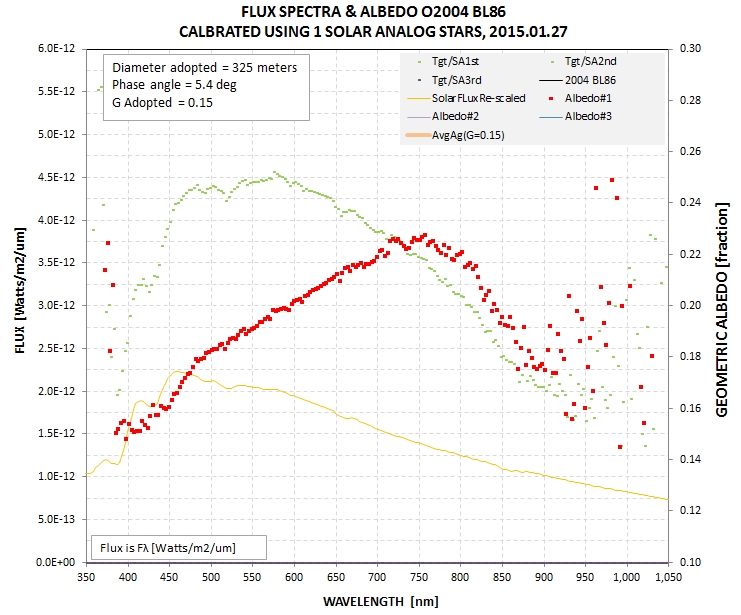
2015.01.27, 21:15 UT: J.
Garlitz reports observations (12") from 04.2 to 10.3 UT
with a G filter (as in RGB) and clear filter.
2015.01.27,
17:40 UT: No more accurately calibrated images
are needed since we have sufficient "phase curve"
coverage. The only remaining task is monitoring for
"mutual events." Just produce a LC for each FOV &
send to me. We're looking for brief fades of very small
depth, so observing unfiltered, or with any preferred
filter, is OK. T. Kaye and I will observe some more with
our SA-100 transmission gratings to get visible spectrum
confirmation of the interesting result that V. Reddy got
from IRTF observations (more on that later).
2015.01.27, 17:40 UT: J.
Gregorio got 11 FOVs from 23.0 UT to 01.7 UT using
V-band & 4-sec exposures.
2015.01.27, 09:50 UT: B. Gary
& T. Kaye are still observing. I have 3.0 hours
worth of g'r'i' images, and a visible spectrum image set
using the SA-100 transmission grating. The SA-100
observations consisted of a
solar analog (SA) star near zenith, BL86 for 20 minutes, another
SA star, another BL86 20-minutes and a third SA star. These
spectra should be capable of producing a solution for albedo vs
wavelength, from 400 nm to 1000 nm, and will show a 920 nm
absorption feature (Band I) if it is present. T. Kaye also
obtained some SA-100 observations with a 32" telescope. We can be
assured of having a wide range of phase angle data for V-band
phase function and a visible spectrum.
2015.01.27, 09:30 UT: Y. Ogmen
obtained 4.5 hours of V-band observations with his 14"
telescope in Cyprus.
2015.01.27,
03:00 UT: V. Reddy reported results of an IR
spectrum that he took last night with the NASA IRTF. The
spectrum covering 0.6 to 2.6 microns and shows something
very interesting, and unusual.
2015.01.27, 02:00 UT: B. Gary
& T. Kaye are running. BG getting g'r'i' now (EL =
12 deg). SA-100 visible spectra when EL is higher.
2015.01.26,
22:50 UT: B. Gary has processed 1/2 hr of r'
images and created the following rotation light curve
(from 3 FOVs). The fitted period of 1.8 hrs can be
misleading, since LC variations are rarely a 1-component
sine wave. The consensus rotation period is now ~ 2.6
hrs (based on S. America observations). The
g'-band LC looks the same. The i'-band data is only
partially processed, but so far it's consistent with the
other two bands. J. Garlitz processed his 1-hr of V-band
images to produce a LC, and a small variation may be
present (but data is noisy due to low elevation).
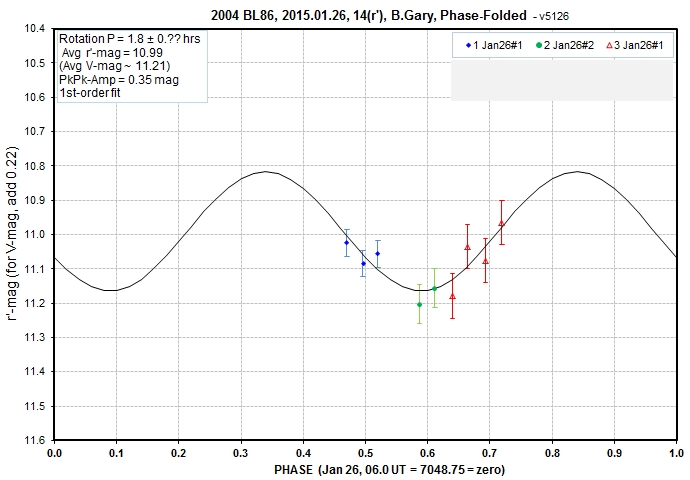
2015.01.26, 19:15 UT: V. Reddy
passed along the following radar image, showing that
BL86 is a binary. It's either from JPL's Goldstone
Tracking Station (thanks to Lance Benner).
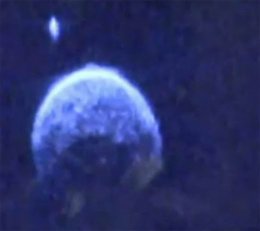
2015.01.26, 18:30 UT: Y. Ogmen
started observing (~18:20 UT). Clear but dew prone.
2015.01.26, 17:00 UT: J.
Gregorio is starting to observe w V filter, 4-sec
exposures. Clear now, but clouds coming. V. Reddy got
IRTF images at ~12 UT.
2015.01.26, 09:20 UT: J.
Garlitz (Oregon, 12") obtained some images, but EL was
low & seeing was poor. K. Schindler (San Francisco,
135mm EFL & FLI CCD) obtained some images during a
clearng and created an animation.
2015.01.26, 08:37 UT: B.Gary
& T.Kaye (Southern Arizona) obs'd for a few hours,
but there was only one clearing, lasting ~ 1/2 hr.
During the clearing image quality was good enough for
deriving g'r'i' mag's (& estimating V-mag) for phase
angle of ~ 55 deg. BL86 was very close to the JPL
Horizons & MPC listings. Persistent clouds, plus
satellite IR images of clouds, led to decision to
shutdown of both observatories at 08:30 UT. Below is a
20x23 'arc crop of 4 images averaged, taken at 07 UT,
with the asteroid showing as a 4-dot sequence moving
northward.

________________________________________________________________________________________________________________________
Introduction
There are 5 section on
this web page: 2004 BL86 Overview,
Observations Needed, Processing, Analysis
and Interpretation. For now
the only ones to consider are the first two. The others will
be important after the several-day observations have been
completed. Here's a hint of what's on this web page: 1) BL86
isn't observable for mid-latitude northern hemisphere
observers until Jan 26.2 UT (i.e., Sunday night at 10 PM,
Arizona local time), 2) among your various telescope
configurations choose the one with the largest FOV, 3) use a
V-band filter (R-band, or even Clear will be acceptable), 3)
adopt an exposure time that keeps the asteroid at the safest
maximum counts (i.e., ~ 40,000 for sharp images, probably
< 5 seconds), 4) be prepared to change FOV location often
because BL86 is moving fast for the first few days.
BL86, as I will refer to it,
is fast-moving and bright. It can be observed by amateurs for
over a week, but there are ~ 4 days where phase angle changes
make observing most important. These are UT dates Jan 26 to
Jan 29. I will refer to observing dates as Day#1 = Jan 25/26,
etc. Here's an overview graph of magnitude and declination
(DE):
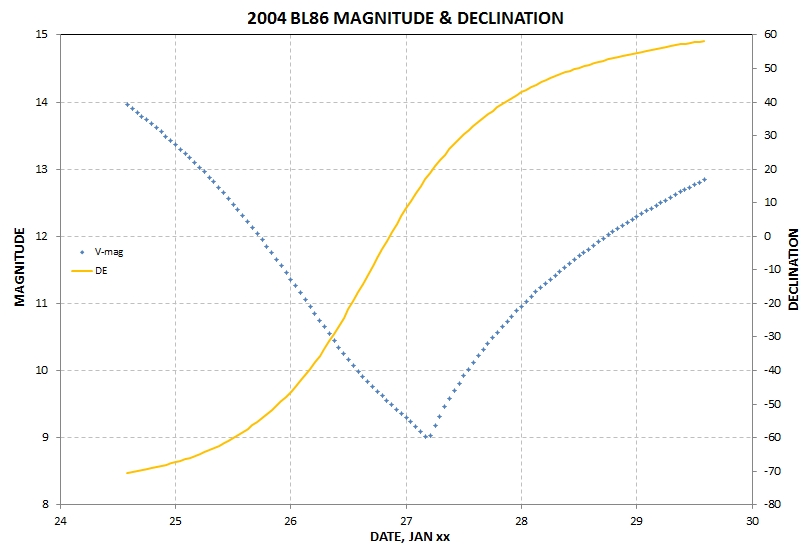


You can download a
spreadsheet containing this info for the interval Jan 24 to
Jan 29 at: link.
Since the uncertainty on RA/DE is small the above spreadsheet
should be adequate for this project.
I suggest using TheSkyX for
planning a night's observations, as well as real-time
guidance. For example, I used it to create the following
observing schedule for my site:
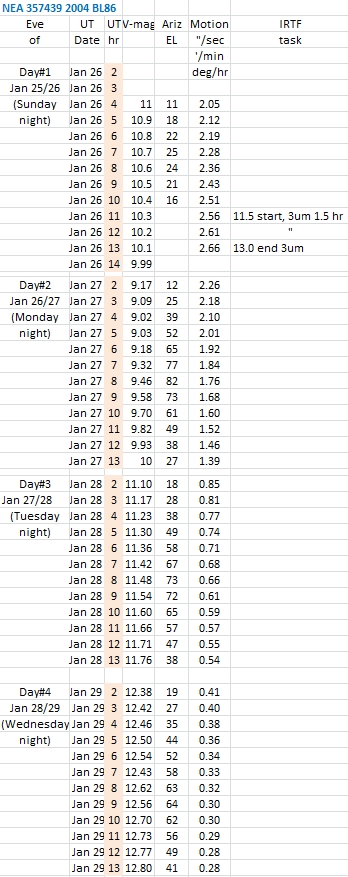
Observers in Europe and the USA will be
measuring magnitude for observing sessions that are as long as
possible. It will be exhausting staying awake all night in
order to change FOV to keep the asteroid track within the FOV,
so surrendering to sleep before dawn is expected. Two of us
will be measuring the spectrum at low resolution in the
visible (Tom Kaye and B. Gary). Dr. Vishnu Reddy will be
obtaining spectra in the infrared (1 to 3 micron) using the
NASA 2-meter IRTF on Mauna Kea on one night. We will compare
all data with rotation phase since it is possible that the
spectrum at visible and IR wavelengths will vary with
rotation.
I will of course be available for
questions and suggestions. My e-mail is B L G A R Y at umich
dot edu.
Exposure Time
The goal is to obtain a set of images for an observing session in
which the asteroid is not "smeared" into a long trail and for
which a circular photometry aperture yields SNR > ~5.
Suppose the rate of motion is 2.0 "arc/second (which equates to
2.0 'arc/minute and 2.0 degree/hour). If your PSF is 4 "arc, then
a PSF crossing time is 2 seconds. A good "rule of thumb" is to
keep exposure time to no more than the PSF crossing time, which
for this example would be 2 seconds.
FOV Changes
It's good to have a big field-of-view (FOV). For example, if your
FOV is 15 'arc square, and rate of motion is 2.0 'arc/minute, then
a 12 'arc track occurs in 6 minutes. There's a big advantage in
having a large FOV; my prime focus (HyperStar on 14-inch Meade)
has FOV = 48 x 71 'arc, so a north/south movement of 40 'arc, for
example, occurs in 20 minutes for this rate of motion example.
Filter Choice
A requirement for doing anything with a fast-moving asteroid
image set is to achieve calibration of all asteroid brightness
measurements. This requires use of background stars for
calibration, and in any image there will be more V-mag's to work
with than for any other band. Therefore, if SNR for short
exposures is sufficient when using a V filter, then use it. Second
choice is R-band (i.e., Rc-band, or pretty picture R band). Third
choice is unfiltered. It's possible to convert any of these
magnitude measurements to just one band, and it required knowledge
of the asteroid's color (or spectrum), which I'll measure.
Therefore, choose any of those filters (V, Rc, R or clear).
You'll know how to estimate SNR for any filter with your
telescope system, but here's a crude guide that I use: SNR = 3 ×
(2.512^(LM - mag)), where LM is limiting magnitude (see graph,
below) and mag is the asteroid's magnitude. Consider the example
of a 14" telescope, 2-second exposures, FWHM = 4 "arc and asteroid
mag = 10.0: LM ~ 19.2 for 60-sec exposures, so for 2-sec exposures
LM ~ 19.2 + 1.25 × Log (2/60) = 17.3; therefore, SNR = 3 ×
(2.512^(17.3 - 10.0)) = 2500. This example illustrates that there
will be plenty of SNR for BL86 on Jan 26/27. A V-band filter
has a "throughput" of ~ 23%, which requires SNR to be reduced by
the ratio 0.23 using the above equations (i.e., SNR = 570).
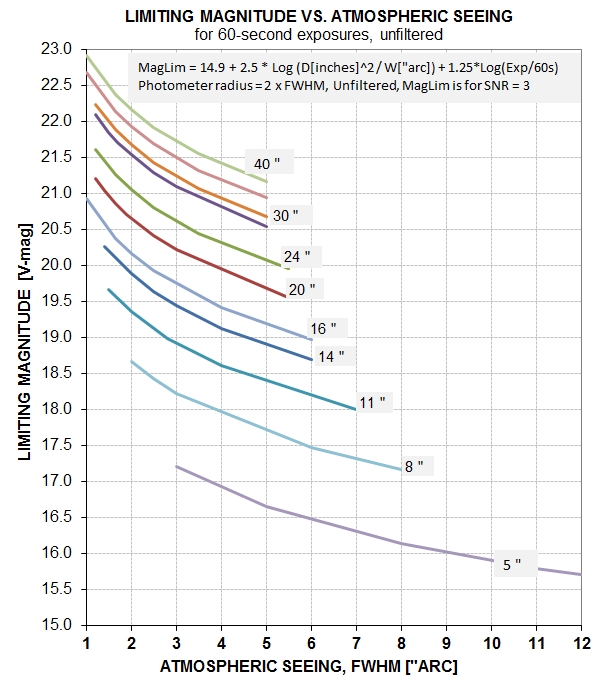
Figure 5. Limiting magnitude for 60-second exposures,
unfiltered vs. telescope aperture and seeing.
Guiding
When exposure times as as short as a few seconds, which will be
the case for fast-moving asteroids, auto-guiding won't be
necessary. Hence, in all images there won't be any "smearing;" all
stars and the asteroid should be "sharp." This is helpful for the
processing phase.
There are two choices for
processing: 1) send images to me for processing (using a
dropbox), or 2) process the images to the stage of having
calibrated magnitudes for the asteroid for each image of an
observing session, and send that to me.
In order to compare V-mag
observations from different observers it will be important
to apply "CCD transformations" to photometry readings. I
know that sounds like a lot of work, but forget about the
classical way of doing this, described everywhere (and at
the AAVSO web site). There's a much simpler method for
doing this, too often neglected by old-fashioned purists.
It's a simple procedure: 1) apply a "first magnitude offset
parameter" to all asteroid measured mag's so that they are
approximately zero, 2) for each reference star in the FOV
being used for calibration, plot "measured (instrument)
magnitude minus true magnitude" versus the star's color
(your choice, e.g., B-V, or g'-r', etc), 3) create a curve
(or straight line, or whatever shape mimics the reference
star plot), and adjust it vertically, using a "second
magnitude offset parameter" until the curve crosses zero at
the asteroid's color, 4) adjust the "first magnitude offset
parameter" until the reference star data fit the curve that
you decided represents their variation with star color. True
mag's refer to the AAVSO APASS BVg'r'i' set, and can be
obtained from the UCAC4 catalog (or the AAVSO web site, or
the Vizier web site).
If you really want to get good
quality calibrated mag's for the asteroid, maybe you have
the patience for the procedure
I use. Otherwise, use whatever CCD transformation
procedure you like to convert your instrumental mag's to
calibrated V-band mag's.
I'll perform most of the "analysis." This
will consist of combining data sets from different
observers, and putting them on the same magnitude scale.
I'll construct a plot of "V-mag vs. phase angle" and begin
analyzing it for determining albedo and size (the slope of
the phase function can be converted to albedo, and this can
be used to estimate size). More description later.
Dr. Vishnu Reddy will perform the
interpretation, possibly with the collaboration of Dr.
Jian-Yang Li. Our job is to GET THE DATA!
BL86 Observer Team
Yenal Ogmen, Cyprus, 14"
Joao Gregorio, Portugal, 12"
Paul Benni, Massachussets, 11" & telephoto
Tom Kaye, Arizona, 32" & 5"
Bruce Gary, Arizona, 14"
Vishnu Reddy, Arizona, 2-meter IRTF (Mauna Kea) & 14"
Joe Garlitz, Oregon, 12"
Karsten Schindler, California, telephoto lens with FLI CCD

This site was opened 2015.01.24. Nothing on this
web page is copyrighted. BGary web sites